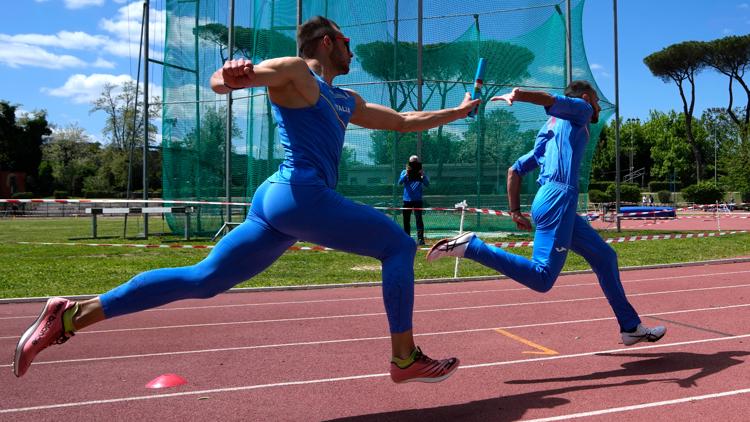PARIS, France — He’s the Billy Beane of Olympic relays, using math and a massive database to win like the hero of “Moneyball.”
One of the biggest reasons why Italy has been able to contend with the much faster Americans and the more talented Jamaicans on a consistent basis lately is the relay maestro Filippo Di Mulo, who has broken down baton-exchanges to a science and keeps it all meticulously recorded in a nearly 25-year-old database.
The Sicilian coached the Azzurri to 4x100 gold in Tokyo, silver at last year’s world championships, and another gold at the recent European Championships. His team is a strong contender at the Paris Games when the men’s 4x100 gets underway with Thursday's heats, followed by the final on Friday.
“We’re not the fastest in the world. The Americans have more speed. But we’re probably the best at the exchanges. And it shows,” said Lorenzo Patta, who led off the winning relay in Tokyo.
By taking into account every athlete’s speed entering and exiting the exchange zone, plus stride length and foot size, Di Mulo has created an algorithm to determine where exactly in each 30-meter exchange zone his runners should position themselves for their starting positions.
The sprinters count a determined number of steps to get to their assigned starting position.
“But no athlete is a machine; they’re human beings,” Di Mulo said in an interview with The Associated Press at Italy’s relay training camp in Rome in April. “So you’ve got to account for issues like starting too soon or too late. But by knowing every athlete’s tendencies, I can adapt. So I don’t actually use the number provided by the algorithm. I adapt it to each athlete’s characteristics.”
Di Mulo coaches all of Italy’s relays on the track. And the Azzurri have qualified in all five relays for Paris.
“He’s a magician,” said Zaynab Dossu, Italy’s top female 100-meter sprinter. “He thinks about all the details and all we have to do is run.”
The belief in Di Mulo is also part of the equation. It’s why Tokyo 100-meter champion Marcell Jacobs often sets aside time for relay training camps.
Di Mulo first saw signs that his methods were working with a 4x100 silver at the 2010 European Championships in Barcelona.
“We ran 38.17 with athletes whose best times were 10.46, 10.43, 10.16 and 10.17. So if you calculate the ability index — subtracting the relay result from the sum of the individual athletes’ best times — it came out to 3.05,” Di Mulo said.
“So if I had slightly faster runners, I always thought we could win,” Mulo added. “Then Jacobs ran 9.80 (to win individual gold) and that’s what happened."
The other members of the relay in 2021 were Filippo Tortu (10.10 personal best that year), Patta (10.13) and Fausto Desalu (10.38).
Italy won gold in Tokyo in 37.50, so its ability index was 2.91 — right near the 3-second mark that Di Mulo holds as his golden standard.
If the American men had a 3-second ability index, they would set the world record virtually every year. But they don’t.
And it’s not just about dropped batons — although those have happened often.
The Americans haven’t won the men’s 4x100 at an Olympics in nearly a quarter century — since the 2000 Sydney Games.
“They usually subtract 1.2, 1.8, maybe 2 seconds when they’re going well,” Di Mulo said.
The top four finishers at the U.S. trials this year were Noah Lyles (9.83), Kenny Bednarek (9.87), Fred Kerley (9.88) and Christian Coleman (9.93). Add up their times (39.51), subtract 3 and the result of 36.51 would break the world record that Usain Bolt’s Jamaica set at 36.84 in 2012.
A little more than a decade ago, Di Mulo wrote to USA Track & Field offering to coach the Americans.
“I told them I would coach the men’s team for free and that they would only have to pay me if we set the world record or won the Olympics,” Di Mulo said. “They thanked me for the offer but they said they had full faith in their own coaches.”
At 5-foot-8 (1.73 meters) and 132 pounds (60 kilograms), Patta is tiny compared to the more muscular sprinters.
With a personal best of 10.13 seconds, he’s not all that fast, either.
What Patta, however, does better than anyone else on Italy’s team is grab and hand off the baton — especially on the receiving end.
Right arm stretched backward perfectly straight, eyes looking forward, Patta takes the baton in one seamless motion.
“When Patta’s involved, the exchange-zone times have been 2.66 seconds; 2.80 when it goes poorly,” Di Mulo said, noting that anything under 3 seconds is considered efficient.
Di Mulo didn’t even know the full extent of Patta’s capabilities when he put him in position to lead off the relay in Tokyo. That’s because Patta was making only his second appearance on the national team.
At last year’s worlds, Di Mulo moved Patta to the third position so he could be involved in two handoffs.
The Italians practice their handoffs by standing still and moving the baton rapidly from one to another for nearly a half hour during every training session. Sometimes with their eyes closed.
“How many repetitions does it take for a gymnast on the parallel bars or rings to get their routine perfect? And we’re coming into the exchange zone at 40 kph (25 mph). These are decisions that are made in a fraction of a second,” Di Mulo said.
“Either you’ve done the repetitions or you can’t do it. Or maybe you can do it once but then not again. The more you practice it, the more you increase the chance of doing it well. Because mistakes are always possible. You could practice it a thousand times and still make a mistake. That’s just how the relay is.”
Di Mulo started compiling his database on Excel in 2001.
“It would make your head spin,” he said. “But I like statistics.”
After every training session and race, Di Mulo writes down all sorts of times and measurements in a notebook. Then he transfers them to an iPad and finally, when he gets home, to the database on his computer.
“It takes hours and hours,” he said. “Sometimes I make my wife do it.”
So what exactly does the database look like and how does Di Mulo’s algorithm work?
That’s top secret. Even for members of his team.
“He’s never even let us take a peek,” Patta said.
With Jacobs in second position, Patta third and Tortu the anchor, Di Mulo had been lacking the ideal leadoff man.
Then in June, Chituru Ali took the silver medal behind Jacobs at the European Championships. Ten days later Ali ran a personal best 9.96 to become the third Italian to break the 10-second barrier after Tortu and Jacobs.
But Ali doesn't like the idea of running along the curve of the track, so Matteo Melluzzo could keep his starting spot from the Euros victory.
“We’re the defending champions and we’re still not expected to win,” Jacobs said. “We can run freely.”



